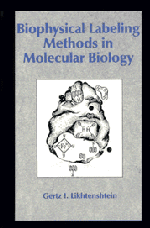Book contents
- Frontmatter
- Contents
- Preface
- Abbreviations
- 1 The method of spin labeling
- 2 Double-labeling techniques
- 3 Fluorescent labeling methods
- 4 Triplet labeling methods
- 5 Mössbauer spectroscopy, electron scattering, and other labeling methods
- 6 Studies of proteins and enzymes: structure, dynamics, and mechanism of action
- 7 Structure and dynamics of membranes
- 8 Nucleic acids and other biological systems: biological assays
- Conclusion
- References
- Index
4 - Triplet labeling methods
Published online by Cambridge University Press: 29 January 2010
- Frontmatter
- Contents
- Preface
- Abbreviations
- 1 The method of spin labeling
- 2 Double-labeling techniques
- 3 Fluorescent labeling methods
- 4 Triplet labeling methods
- 5 Mössbauer spectroscopy, electron scattering, and other labeling methods
- 6 Studies of proteins and enzymes: structure, dynamics, and mechanism of action
- 7 Structure and dynamics of membranes
- 8 Nucleic acids and other biological systems: biological assays
- Conclusion
- References
- Index
Summary
In the past few years, experimental techniques have so improved that it has become possible to study the triplet excited state of a chromophore by its phosphorescence or delayed fluorescence emission both in frozen solution and in liquids at room temperature. A number of the properties of phosphorescence, such as radiative and radiationless deactivation of the excited states, polarization, relaxation shifts, dynamic quenching, formation of exciplexes, etc., are similar to those of fluorescence described in Chapter 3. On the other hand, there are some essential features of triplet probes that distinguish them from fluorescent tables. In particular, paramagnetism and the relatively long lifetimes of excited triplet states allow us to extend the boundaries of investigation of biological systems as compared with the method of fluorescence (Kotelnikov et al. 1979; Maniara et al. 1988; Likhtenshtein et al. 1982; Shin et al. 1988; Mekler et al. 1983; Sudha et al. 1984; Mekler & Likhtenshtein 1986; Van der Kooi et al. 1990).
Peculiarities of triplet excited states
Direct absorption of a light quantum by the ground singlet state (S0), with the formation of triplet states (T1, T2) accompanied by a change in the spin of the system, is forbidden according to the law of conservation of momentum (spin conservation). Because of spin–orbital and spin–spin electron–nucleus interactions, the probability of the S0 → Ti transition is not equal to zero, though it is very small. However, in general the triplet state is reached via an S0 → S1 transition, followed by S1 → T1 interconversion.
- Type
- Chapter
- Information
- Biophysical Labeling Methods in Molecular Biology , pp. 116 - 135Publisher: Cambridge University PressPrint publication year: 1993



